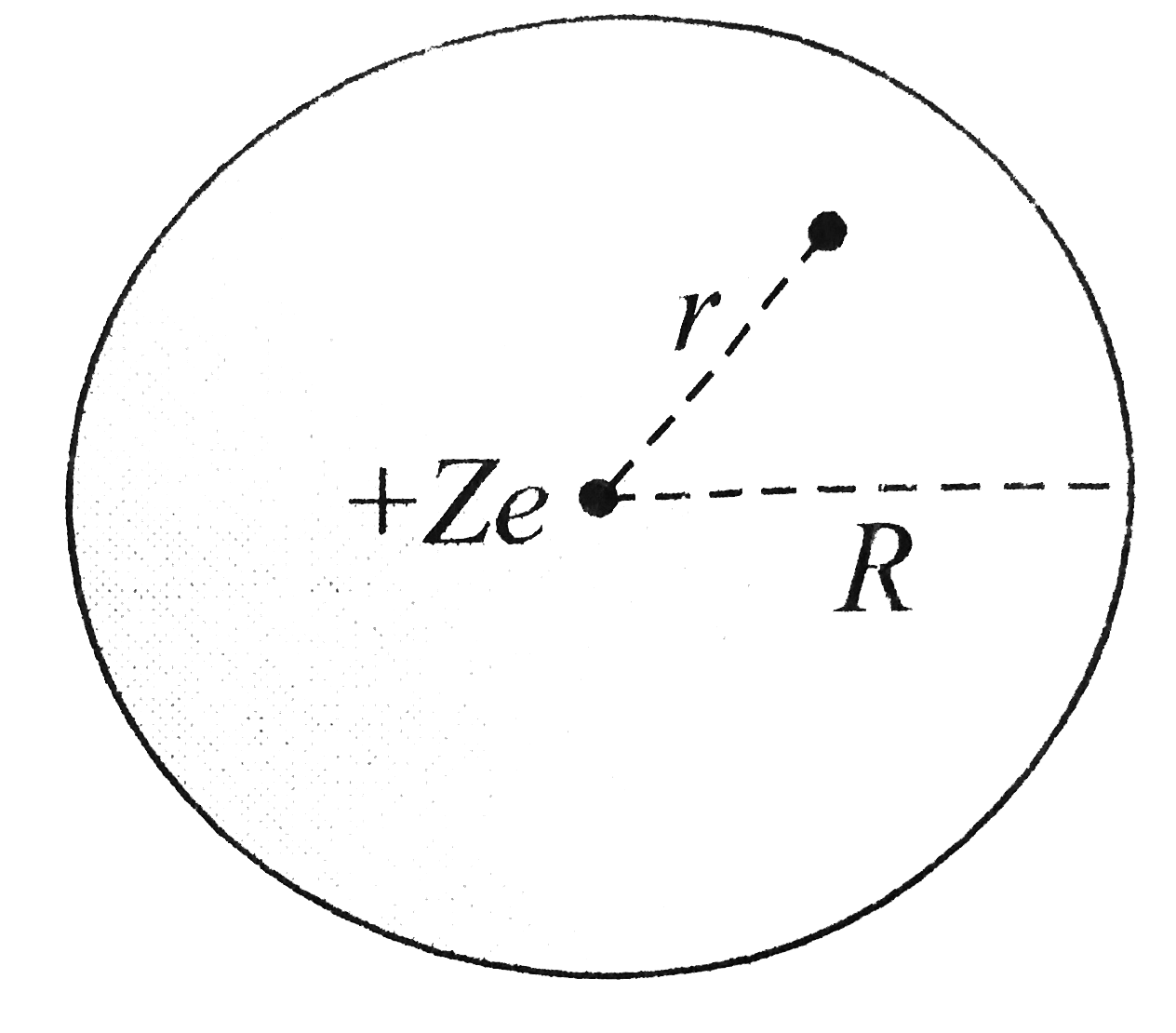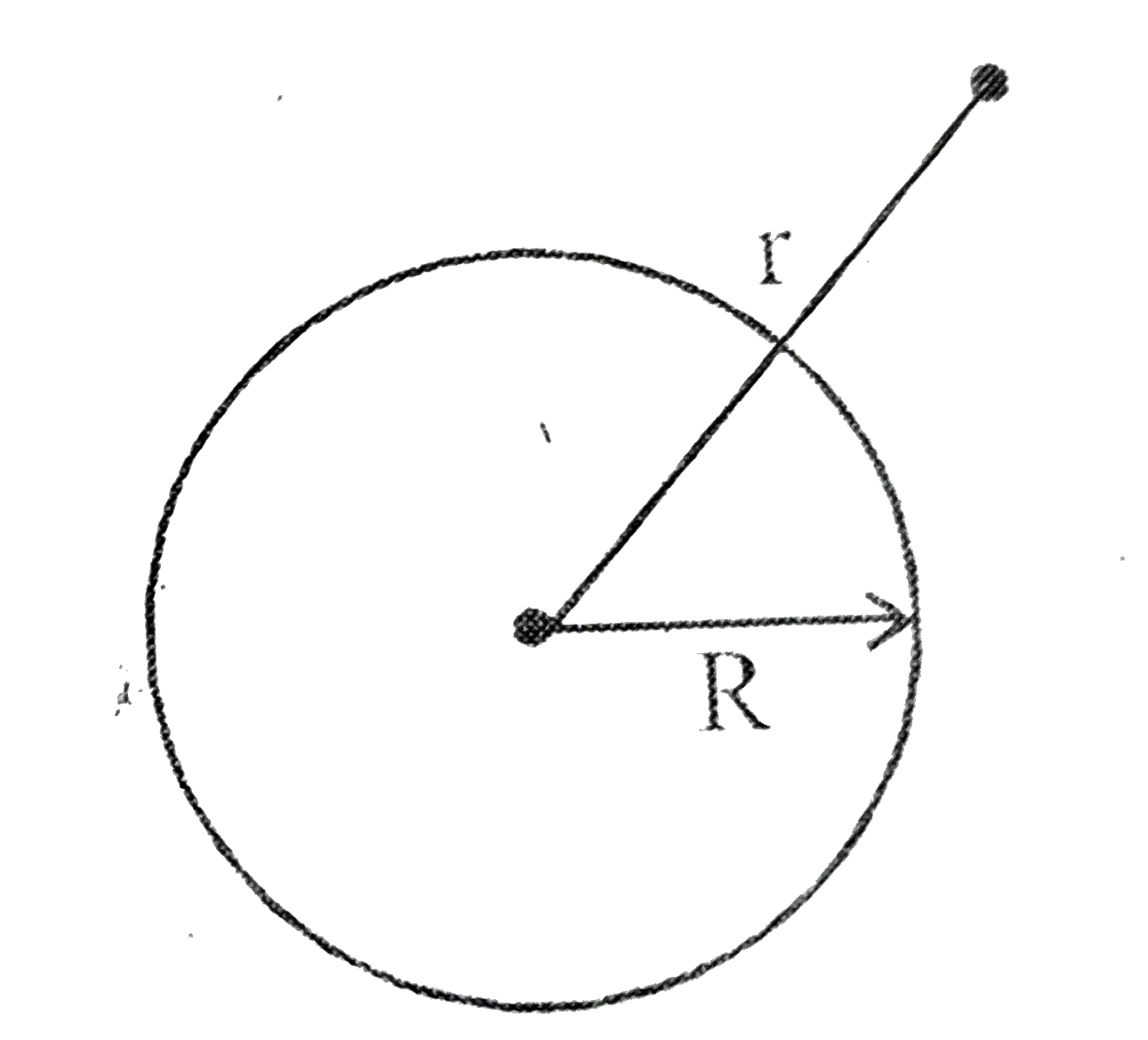An early model for an atom considered to have a positively charged point nucleus of charge Ze surrounded by a uniform density of negative charge up to a radius R. The atom as a whole is neutral. For this model, what is the electric field a distance r from the nucleus, where ?
0
The correct Answer is:D
To solve the problem, we need to find the electric field at a distance r from the nucleus of an atom, where r>R (the radius of the atom).
1. Understanding the Charge Distribution:
- The atom has a positively charged nucleus with charge Ze (where Z is the atomic number and e is the elementary charge).
- Surrounding the nucleus, there is a uniform density of negative charge that extends up to a radius R.
- The atom as a whole is neutral, meaning the total positive charge from the nucleus is balanced by the total negative charge from the electrons.
2. Applying Gauss's Law:
- Gauss's Law states that the electric flux Φ through a closed surface is equal to the charge enclosed Qenc divided by the permittivity of free space ϵ0:
Φ=∮E⋅dS=Qencϵ0
3. Choosing a Gaussian Surface:
- We choose a spherical Gaussian surface of radius r such that r>R. This means the surface is outside the region where the negative charge is distributed.
4. Calculating the Enclosed Charge:
- Inside the Gaussian surface, the charge from the nucleus is +Ze.
- The total negative charge from the electrons is −Ze (since the atom is neutral).
- Therefore, the total charge enclosed by the Gaussian surface is:
Qenc=+Ze+(−Ze)=0
5. Applying Gauss's Law:
- Since the enclosed charge Qenc=0, we can substitute this into Gauss's Law:
∮E⋅dS=0ϵ0=0
- This implies that the electric field E at a distance r from the nucleus (where r>R) is zero.
6. Conclusion:
- Therefore, the electric field at a distance r from the nucleus, where r>R, is:
E=0
Final Answer:
The electric field at a distance r from the nucleus, where r>R, is E=0.
- The atom has a positively charged nucleus with charge Ze (where Z is the atomic number and e is the elementary charge).
- Surrounding the nucleus, there is a uniform density of negative charge that extends up to a radius R.
- The atom as a whole is neutral, meaning the total positive charge from the nucleus is balanced by the total negative charge from the electrons.
- Gauss's Law states that the electric flux Φ through a closed surface is equal to the charge enclosed Qenc divided by the permittivity of free space ϵ0:
Φ=∮E⋅dS=Qencϵ0
- We choose a spherical Gaussian surface of radius r such that r>R. This means the surface is outside the region where the negative charge is distributed.
- Inside the Gaussian surface, the charge from the nucleus is +Ze.
- The total negative charge from the electrons is −Ze (since the atom is neutral).
- Therefore, the total charge enclosed by the Gaussian surface is:
Qenc=+Ze+(−Ze)=0
- Since the enclosed charge Qenc=0, we can substitute this into Gauss's Law:
∮E⋅dS=0ϵ0=0
- This implies that the electric field E at a distance r from the nucleus (where r>R) is zero.
- Therefore, the electric field at a distance r from the nucleus, where r>R, is:
E=0
The electric field at a distance r from the nucleus, where r>R, is E=0.
Topper's Solved these Questions
- BOOK - RESNICK AND HALLIDAYCHAPTER - ELECTRIC CHARGES AND FIELDSEXERCISE - Practice Questions (More than one correct Type )3videos
ELECTRIC CHARGES AND FIELDS
- BOOK - RESNICK AND HALLIDAYCHAPTER - ELECTRIC CHARGES AND FIELDSEXERCISE - Practice Questions (Linked Comprehension)5videos
ELECTRIC CHARGES AND FIELDS
- BOOK - RESNICK AND HALLIDAYCHAPTER - ELECTRIC CHARGES AND FIELDSEXERCISE - Problems63videos
ELECTRIC CHARGES AND FIELDS
- BOOK - RESNICK AND HALLIDAYCHAPTER - ELASTICITYEXERCISE - PRACTICE QUESTIONS (Integer Type)3videos
ELASTICITY
- BOOK - RESNICK AND HALLIDAYCHAPTER - ELECTRIC POTENTIALEXERCISE - (PRACTICE QUESTIONS) Integer Type1videos
ELECTRIC POTENTIAL
Similar Questions
According to early model of an atom,the atom is considered it to have a positively charged point nucleus of charge Ze surrounded by a uniform density of negative charge up to a radius R. The atom as a whole is neutral. The electric field at a distancer from the nucleus is (r<R)
 View Solution
View SolutionAn early model for an atom considered it to have a positivelly charged point nucleus of charge +Ze surrounded by a uniform density of negative charge up to a radius R. The atom as whole is neutral. For this model , what is the electric field at a distance r from the nucleus when
r<R
r=R ?Use Gauss's theoremView Solution
Knowledge Check
- Question 1 - Select One
According to early model of an atom, the atom is considered it to have a positively charged point nucleus of charge Ze surrounded by a uniform density of negative charge up to a radius R. The atom as a whole is neutral. The electric field at a distance r from the nucleus is (r<R)
 AZe4πε0[rR3−1r2]BZe4πε0[rR3+1r2]CZe4πε0[1r2−rR3]DZe4πε0[1r3−rR2]
AZe4πε0[rR3−1r2]BZe4πε0[rR3+1r2]CZe4πε0[1r2−rR3]DZe4πε0[1r3−rR2] - Question 2 - Select One
A conducting sphere of radius R is charged to a potential of V volts. Then the electric field at a distance r(>R) from the centre of the sphere would be
ARVr2BVRCrVR2DR2Vr2 - Question 3 - Select One
A conducting sphere of radius R is charged to a potential of V volts. Then the electric field at a distance r(>R) from the centre of the sphere would be
AVrBR2Vr3CRVr2DrVR2
According to early model of an atom,the atom is considered it to have a positively charged point nucleus of charge Ze surrounded by a uniform density of negative charge up to a radius R. The atom as a whole is neutral. The electric field at a distancer from the nucleus is (r<R)
 View Solution
View SolutionState Gauss 'law in electrostatics.
Consider an overall neutral sphere of radius R. This sphere has a point charge +Q at its centre and this positive charge is surrounded by a uniform density ρ of negative charges up to a radius R.
Use Gauss, law to obtain expression for the electric field , of this sphere , at a point distant r, from its centre ,where
r<R,
r>R
Show that these two expressions give identical results, for the electric field, at r= R.View SolutionIf the potential at the center of a uniformly charged sphere of radius R is V then electric field at a distance r from the center of sphere will be (r<R) : -
 View Solution
View SolutionA point charge q is placed at the origin . How does the electric field due to the charge very with distance r from the origin ?
View SolutionA hallow metal sphere of radius R is uniformly charged. The electric field due to the sphere at a distance r from the centre:
View Solution

